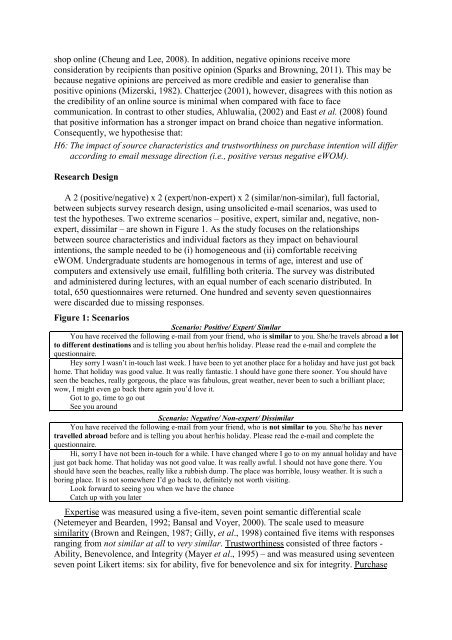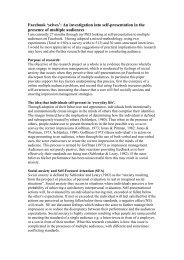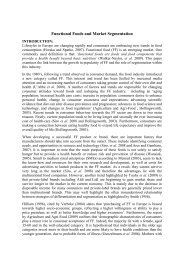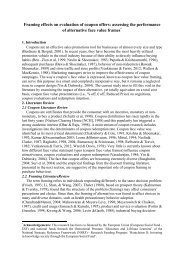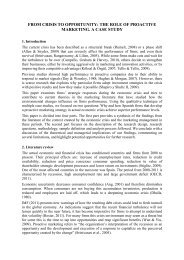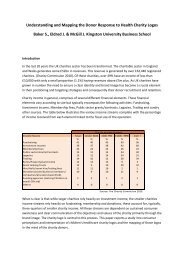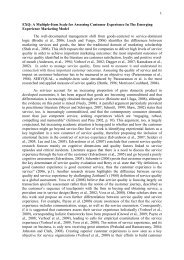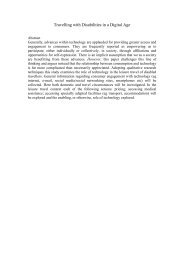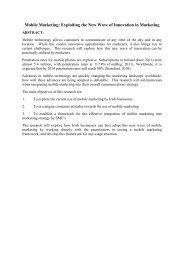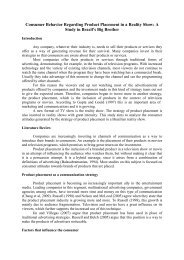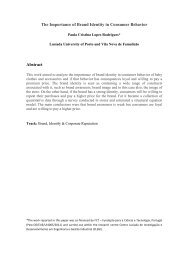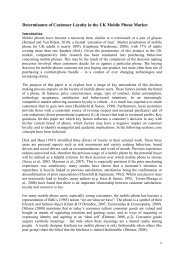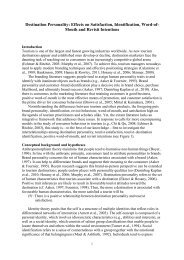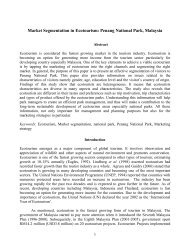The influence of positive and negative eWOM on purchase intention
The influence of positive and negative eWOM on purchase intention
The influence of positive and negative eWOM on purchase intention
You also want an ePaper? Increase the reach of your titles
YUMPU automatically turns print PDFs into web optimized ePapers that Google loves.
shop <strong>on</strong>line (Cheung <str<strong>on</strong>g>and</str<strong>on</strong>g> Lee, 2008). In additi<strong>on</strong>, <str<strong>on</strong>g>negative</str<strong>on</strong>g> opini<strong>on</strong>s receive more<br />
c<strong>on</strong>siderati<strong>on</strong> by recipients than <str<strong>on</strong>g>positive</str<strong>on</strong>g> opini<strong>on</strong> (Sparks <str<strong>on</strong>g>and</str<strong>on</strong>g> Browning, 2011). This may be<br />
because <str<strong>on</strong>g>negative</str<strong>on</strong>g> opini<strong>on</strong>s are perceived as more credible <str<strong>on</strong>g>and</str<strong>on</strong>g> easier to generalise than<br />
<str<strong>on</strong>g>positive</str<strong>on</strong>g> opini<strong>on</strong>s (Mizerski, 1982). Chatterjee (2001), however, disagrees with this noti<strong>on</strong> as<br />
the credibility <str<strong>on</strong>g>of</str<strong>on</strong>g> an <strong>on</strong>line source is minimal when compared with face to face<br />
communicati<strong>on</strong>. In c<strong>on</strong>trast to other studies, Ahluwalia, (2002) <str<strong>on</strong>g>and</str<strong>on</strong>g> East et al. (2008) found<br />
that <str<strong>on</strong>g>positive</str<strong>on</strong>g> informati<strong>on</strong> has a str<strong>on</strong>ger impact <strong>on</strong> br<str<strong>on</strong>g>and</str<strong>on</strong>g> choice than <str<strong>on</strong>g>negative</str<strong>on</strong>g> informati<strong>on</strong>.<br />
C<strong>on</strong>sequently, we hypothesise that:<br />
H6: <str<strong>on</strong>g>The</str<strong>on</strong>g> impact <str<strong>on</strong>g>of</str<strong>on</strong>g> source characteristics <str<strong>on</strong>g>and</str<strong>on</strong>g> trustworthiness <strong>on</strong> <strong>purchase</strong> intenti<strong>on</strong> will differ<br />
according to email message directi<strong>on</strong> (i.e., <str<strong>on</strong>g>positive</str<strong>on</strong>g> versus <str<strong>on</strong>g>negative</str<strong>on</strong>g> <str<strong>on</strong>g>eWOM</str<strong>on</strong>g>).<br />
Research Design<br />
A 2 (<str<strong>on</strong>g>positive</str<strong>on</strong>g>/<str<strong>on</strong>g>negative</str<strong>on</strong>g>) x 2 (expert/n<strong>on</strong>-expert) x 2 (similar/n<strong>on</strong>-similar), full factorial,<br />
between subjects survey research design, using unsolicited e-mail scenarios, was used to<br />
test the hypotheses. Two extreme scenarios – <str<strong>on</strong>g>positive</str<strong>on</strong>g>, expert, similar <str<strong>on</strong>g>and</str<strong>on</strong>g>, <str<strong>on</strong>g>negative</str<strong>on</strong>g>, n<strong>on</strong>expert,<br />
dissimilar – are shown in Figure 1. As the study focuses <strong>on</strong> the relati<strong>on</strong>ships<br />
between source characteristics <str<strong>on</strong>g>and</str<strong>on</strong>g> individual factors as they impact <strong>on</strong> behavioural<br />
intenti<strong>on</strong>s, the sample needed to be (i) homogeneous <str<strong>on</strong>g>and</str<strong>on</strong>g> (ii) comfortable receiving<br />
<str<strong>on</strong>g>eWOM</str<strong>on</strong>g>. Undergraduate students are homogenous in terms <str<strong>on</strong>g>of</str<strong>on</strong>g> age, interest <str<strong>on</strong>g>and</str<strong>on</strong>g> use <str<strong>on</strong>g>of</str<strong>on</strong>g><br />
computers <str<strong>on</strong>g>and</str<strong>on</strong>g> extensively use email, fulfilling both criteria. <str<strong>on</strong>g>The</str<strong>on</strong>g> survey was distributed<br />
<str<strong>on</strong>g>and</str<strong>on</strong>g> administered during lectures, with an equal number <str<strong>on</strong>g>of</str<strong>on</strong>g> each scenario distributed. In<br />
total, 650 questi<strong>on</strong>naires were returned. One hundred <str<strong>on</strong>g>and</str<strong>on</strong>g> seventy seven questi<strong>on</strong>naires<br />
were discarded due to missing resp<strong>on</strong>ses.<br />
Figure 1: Scenarios<br />
Scenario: Positive/ Expert/ Similar<br />
You have received the following e-mail from your friend, who is similar to you. She/he travels abroad a lot<br />
to different destinati<strong>on</strong>s <str<strong>on</strong>g>and</str<strong>on</strong>g> is telling you about her/his holiday. Please read the e-mail <str<strong>on</strong>g>and</str<strong>on</strong>g> complete the<br />
questi<strong>on</strong>naire.<br />
Hey sorry I wasn’t in-touch last week. I have been to yet another place for a holiday <str<strong>on</strong>g>and</str<strong>on</strong>g> have just got back<br />
home. That holiday was good value. It was really fantastic. I should have g<strong>on</strong>e there so<strong>on</strong>er. You should have<br />
seen the beaches, really gorgeous, the place was fabulous, great weather, never been to such a brilliant place;<br />
wow, I might even go back there again you’d love it.<br />
Got to go, time to go out<br />
See you around<br />
Scenario: Negative/ N<strong>on</strong>-expert/ Dissimilar<br />
You have received the following e-mail from your friend, who is not similar to you. She/he has never<br />
travelled abroad before <str<strong>on</strong>g>and</str<strong>on</strong>g> is telling you about her/his holiday. Please read the e-mail <str<strong>on</strong>g>and</str<strong>on</strong>g> complete the<br />
questi<strong>on</strong>naire.<br />
Hi, sorry I have not been in-touch for a while. I have changed where I go to <strong>on</strong> my annual holiday <str<strong>on</strong>g>and</str<strong>on</strong>g> have<br />
just got back home. That holiday was not good value. It was really awful. I should not have g<strong>on</strong>e there. You<br />
should have seen the beaches, really like a rubbish dump. <str<strong>on</strong>g>The</str<strong>on</strong>g> place was horrible, lousy weather. It is such a<br />
boring place. It is not somewhere I’d go back to, definitely not worth visiting.<br />
Look forward to seeing you when we have the chance<br />
Catch up with you later<br />
Expertise was measured using a five-item, seven point semantic differential scale<br />
(Netemeyer <str<strong>on</strong>g>and</str<strong>on</strong>g> Bearden, 1992; Bansal <str<strong>on</strong>g>and</str<strong>on</strong>g> Voyer, 2000). <str<strong>on</strong>g>The</str<strong>on</strong>g> scale used to measure<br />
similarity (Brown <str<strong>on</strong>g>and</str<strong>on</strong>g> Reingen, 1987; Gilly, et al., 1998) c<strong>on</strong>tained five items with resp<strong>on</strong>ses<br />
ranging from not similar at all to very similar. Trustworthiness c<strong>on</strong>sisted <str<strong>on</strong>g>of</str<strong>on</strong>g> three factors -<br />
Ability, Benevolence, <str<strong>on</strong>g>and</str<strong>on</strong>g> Integrity (Mayer et al., 1995) – <str<strong>on</strong>g>and</str<strong>on</strong>g> was measured using seventeen<br />
seven point Likert items: six for ability, five for benevolence <str<strong>on</strong>g>and</str<strong>on</strong>g> six for integrity. Purchase


